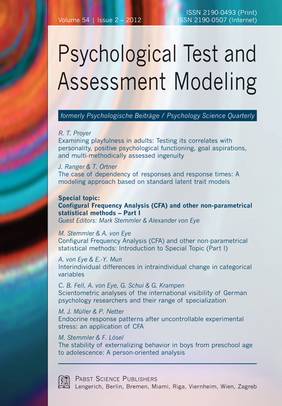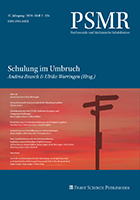Psychological Test and Assessment Modeling, Volume 54, 2012 (2)
Examining playfulness in adults: Testing its correlates with personality, positive psychological functioning, goal aspirations, and multi-methodically assessed ingenuity
René T. Proyer
Abstract | ![]() PDF of the full article
PDF of the full article
The case of dependency of responses and response times: A modeling approach based on standard latent trait models
Jochen Ranger & Tuulia Ortner
Abstract | ![]() PDF of the full article
PDF of the full article
Special topic:
Configural Frequency Analysis (CFA) and other non-parametrical statistical methods - Part I
Guest Editors: Mark Stemmler & Alexander von Eye
Configural Frequency Analysis (CFA) and other non-parametrical statistical methods: Introduction to Special Topic (Part I)
Mark Stemmler & Alexander von Eye (Guest Editors)![]() PDF of the full article
PDF of the full article
Interindividual differences in intraindividual change in categorical variables
Alexander von Eye & Eun-Young Mun
Abstract | ![]() PDF of the full article
PDF of the full article
Scientometric analyses of the international visibility of German psychology researchers and their range of specialization
Clemens B. Fell, Alexander von Eye, Gabriel Schui & Günter Krampen
Abstract | ![]() PDF of the full article
PDF of the full article
Endocrine response patterns after uncontrollable experimental stress: an application of CFA
Matthias J. Müller & Petra Netter
Abstract | ![]() PDF of the full article
PDF of the full article
The stability of externalizing behavior in boys from preschool age to adolescence: A person-oriented analysis
Mark Stemmler & Friedrich Lösel
Abstract | ![]() PDF of the full article
PDF of the full article
Examining playfulness in adults: Testing its correlates with personality, positive psychological functioning, goal aspirations, and multi-methodically assessed ingenuity
René T. Proyer
Abstract
The prime aim of this set of studies was to test the disposition to play (playfulness) in adults in its relation with various measures of personality but also ability (self-estimated but also psychometrically measured ingenuity). Study 1 (n = 180) shows that adults playfulness relates primarily to extraversion, lower conscientiousness, and higher endorsements of culture; joy of being laughed at (gelotophilia) and agreeableness were also predictive in a regression analysis; Study 2 (n = 264) shows that playfulness relates primarily to a high expectation of intrinsic and a low expectation of extrinsic goals as well as greater intrinsic and lower extrinsic importance of goals (for expressive and fun-variants of playfulness); Study 3 (n = 212) shows that playfulness relates to greater self-perception of ones degree of ingenuity and psychometric ingenuity correlated primarily with greater spontaneous and creative variants of playfulness (in about the same range for origence and fluidity of the productions). Overall, the findings were in line with the expectations and could stimulate further studies of playfulness in adults.
Key words: adult playfulness; divergent thinking; life goals; life satisfaction; well-being
Dr. René Proyer
Department of Psychology
University of Zurich
Binzmühlestrasse 14/7
8050 Zurich, Switzerland
r.proyer@psychologie.uzh.ch
The case of dependency of responses and response times: A modeling approach based on standard latent trait models
Jochen Ranger & Tuulia Ortner
Abstract
When modeling responses and response times in tests with latent trait models, the assumption of conditional independence between responses and response times might be too strong in the case that both data are gained from reactions to the same item. In order to account for the possible dependency of responses and response times from the same item, a generalization of the model of van der Linden (2007) is proposed. The basic idea consists in the assumption of a latent continuous response that underlies the observed binary response. This latent response is assumed to be correlated with the corresponding response time. The main advantage of this approach consists in the fact that the marginal models for responses and response times follow well known, standard latent trait models. Model estimation can be accomplished by marginal maximum likelihood estimation. The adequacy of the estimation approach is demonstrated in a small scale simulation study. An empirical data application illustrates the practicability of the approach in practice.
Key words: item response theory, response time, log-normal distribution, conditional independence
Jochen Ranger, PhD
Martin-Luther-University Halle-Wittenberg
Institute for Psychology
Universitätsplatz 10
06108 Halle, Germany
jochen.ranger@psych.uni-halle.de
Interindividual differences in intraindividual change in categorical variables
Alexander von Eye & Eun-Young Mun
Abstract
In this article, we proceed from the assumption that constancy and change in development are not necessarily universal. This deviation from the general assumption of universal developmental patterns is embedded in the theory of person-oriented research. In addition, we propose that constancy and change can reflect local associations instead of associations that cover the entire range of admissible scores. Models of Configural Frequency Analysis are proposed to explore and test hypotheses concerning person-specific local associations in repeated observation data. Three models are considered for lagged data. These models differ in the reasons that are assumed as causes for local associations. The first model reflects variable associations of any kind. The second model reflects case-specific variable associations. The third reflects differences between cases. In an example, data from a study on the development of alcoholics are used. The data in this example reflect case-specific associations in the development of drinking behavior over a span of two years. In the discussion, the person- and the variable-oriented elements of longitudinal research are addressed. In addition, assumptions concerning the independence of longitudinal data are made explicit.
Key words: Configural Frequency Analysis, intraindividual change, interindividual change, lagged data, person-oriented research
Alexander von Eye, PhD
Michigan State University
316 Psychology Building
East Lansing, MI 48824-1116, USA
voneye@msu.edu
Scientometric analyses of the international visibility of German psychology researchers and their range of specialization
Clemens B. Fell, Alexander von Eye, Gabriel Schui & Günter Krampen
Abstract
With reference to the role of networking, accelerated by current developments within large parts of the scientific community, the assumption is examined that the range of specialization of scientists in terms of membership in professional sections of scientific societies is related to the international impact of their publications. The sample consists of 2,788 German psychologists enrolled in the German Psychological Society (Deutsche Gesellschaft für Psychologie, DGPs). A log-linear model suggests that the citation pattern of DGPs members with no citations of their papers published in 2000 or 2005 respectively in the time intervals 2000-2004 or 2005-2009 generally differs from that of their colleagues across four ranges of specialization categories. Configural Frequency Analysis led to the identification of distinct subgroups of scientific specialization and international visibility, i.e., citations by others. Specifically, for those individuals who enjoy international visibility, one key to success seems to be multiple professional specializations with reference to different subdisciplines of psychology.
Key words: Professional specialization, internationality, international impact, citation analysis, Configural Frequency Analysis (CFA)
Gabriel Schui, PhD
Leibniz Institute for Psychology Information (ZPID)
54286 Trier, Germany
gabriel.schui@zpid.de
Endocrine response patterns after uncontrollable experimental stress: an application of CFA
Matthias J. Müller & Petra Netter
Abstract
According to biological stress theories cortisol increases (C+) and testosterone decreases (T-) characterize uncontrollable (UC) stress and the opposite pattern is observed in controllable (CON) stress. The influence of CON/UC on hormone responses to a mental (d2) and a physical (E) short-term stressor was tested by two-sample configural frequency analysis in a cross-over design on 74 healthy males assigned to either CON or UC conditions. Areas under the response curves of saliva C and T were computed and dichotomized (+/-). The evaluation of bivariate response patterns (C/T) revealed that the combination C+T- was significantly more prevalent after UC than after CON with both stressors. The pattern C-T+ constituted a significant discrimination type between CON and UC across both stressors.
Key words: configural frequency analysis; discrimination type; hormone response pattern; cortisol; testosterone
Matthias J. Müller, MD
Vitos Clinical Centre Giessen-Marburg
Licher Str. 106
35394 Giessen, Germany
mjmueller@gmx.de
The stability of externalizing behavior in boys from preschool age to adolescence: A person-oriented analysis
Mark Stemmler & Friedrich Lösel
Abstract
The continuity of externalizing behaviors such as aggression, delinquency and hyperactivity has been noted by many researchers. There is also increasing knowledge on different developmental subtypes of problem behavior. In previous person-oriented analyses we found two types of externalizing problems in boys (Stemmler et al., 2005, 2008; Stemmler & Lösel, 2010). One pattern contained externalizing problems only, whereas the other type showed both externalizing and internalizing problems. The present study addressed these two groups in an extended prospective longitudinal design. It was investigated whether the groups remained stable over time and whether the two types of antisociality were related to offending in adolescence. The sample consisted of 295 boys from the Erlangen-Nuremberg Development and Prevention Study (Lösel et al., 2009). Social behavior was rated by mothers, kindergarten educators, and school teachers; offending was self-reported by the adolescents. The time lag between the first and last data assessment was more than eight years.
Approximately nine percent of the boys revealed stable externalizing behavior problems over the entire assessment period. Criminal behavior correlated positively with externalizing problems and negatively with internalizing problems. In a person-oriented Prediction-Configural Frequency Analysis (P-CFA; von Eye, 2002) the externalizing only pattern could be replicated and suggested high stability over time. Moreover, this pattern was clearly related to self-reported delinquent behavior. In contrast to our previous studies with shorter follow up periods, the combined externalizing and internalizing pattern did not appear as a type. It was also not significantly related to juvenile offending. Potential explanations for these findings are discussed.
Key words: Prediction-Configural Frequency Analysis (P-CFA), proactive and reactive aggression, delinquency, longitudinal research
Mark Stemmler, PhD
University of Erlangen-Nuremberg
Institute of Psychology
Nägelsbachstr. 49c
91052 Erlangen, Germany
mark.stemmler@psy.phil.uni-erlangen.de























